



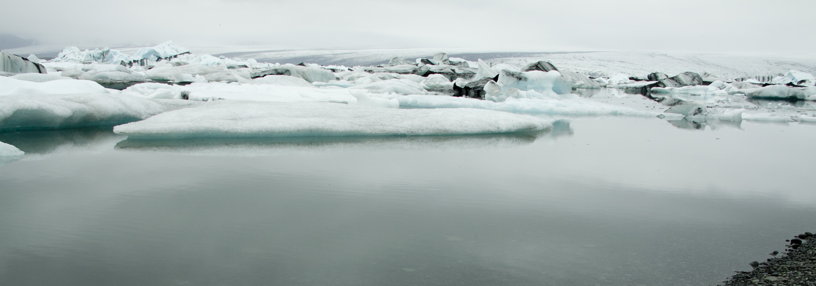
|
| Jökulsárlón, one of the many spectacular views we had of this real tourist attraction. |
Great walking today, and lots of driving as well, but maybe the best part there are no pictures of here, though Mark does on his page.
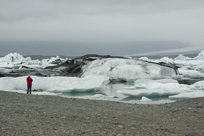
|
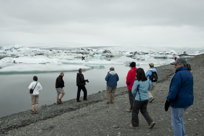
|
| Big image, small. | Big image, small. |
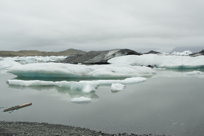
|
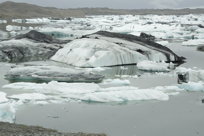
|
| Big image, small. | Big image, small. |
We packed up our things, since we would be moving on to Seyðisfjörður, way over on the East coast, tonight. We then piled into the bus and drove a ways along the coast, to Jökulsárlón (“Glacier River Lagoon”), where we stood on the shore for a while and I took the pictures to the left. I really like the one in the upper left, showing Gisele taking shots—it gives an idea of the scale of the bergs. They’ve floated down the river from the calving glacier upstream, and they stay in the lagoon for a while before either melting or floating out the mouth on the high tide. In the right-hand picture in the top row, that’s Diane, John, Erling, Mark, Gisele, Shirley, Margie, and Jerye. In the picture on the lower right, you can see very well the volcanic grit that’s included in so much of the glacier ice.
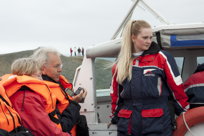
|
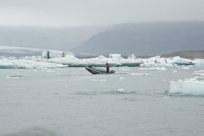
|
| Big image, small. | Big image, small. |
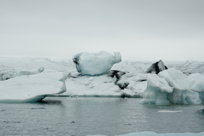
|
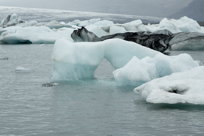
|
| Big image, small. | Big image, small. |
In due time, we piled onto one of the amphibious vehicles that were there for the tourists. They’re huge, but not so huge that they’re invulnerable to damage by the little icebergs that the lagoon is full of. As a result, there were crews out in Zodiacs swirling their wakes to drive the floaters away from our path.
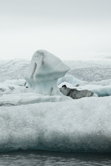
|
| Big image, small. |
The vessels hold I guess two dozen, plus the crew: in addition to us fifteen (twelve walkers, two guides, and Hulda), there were a handful of others, a pair of whom you can see in the top picture, which is the only good shot I got of the guide for this adventure, Helga. Her English was very good, and she explained all sorts of aspects of what we were seeing and sailing amongst. As you can see in that picture also, we were all squeezed into life-jackets. If the vessel had rolled over, I think we would have died of exposure in 20 seconds, life-jacket or no.
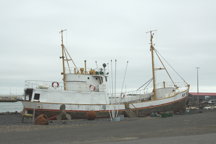
|
| Big image, small. |
From there we drove along the coast to Höfn (“Port”), a fishing town that seems to specialize in langoustine (“Norway lobster”, Nephrops norvegicus, a smaller relative of lobsters. These are the crustacean that are called scampi in Italy.) At the restaurant called Humarhöfnin (“The Lobster Port”), we sat down to one of the best meals we had during the whole tour. About a dozen half-tails (split lengthwise), perfectly grilled with little more than butter, and a simple salad. The tails were so perfectly cooked, and so manifestly completely fresh, that we all alternated between dumbstruck and effusive. An exceptional meal. Mark has a picture, but I didn’t have my camera with me for this special treat.
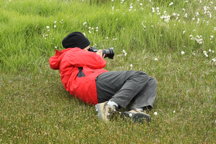
|
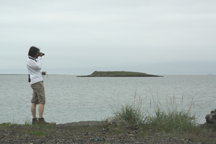
|
| Big image, small. | Big image, small. |
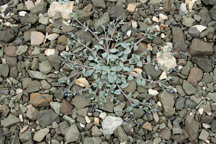
|
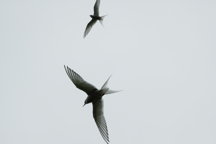
|
| Big image, small. | Big image, small. |
Before lunch, we had taken a short walk along the harbor and the oceanfront. One of the sights was the fishing vessel sunk into the soil that you see above and to the left. As I recall, Mark has some much better shots of it that he didn’t put into his page. But there were lots of other opportunities for picture-taking: you see Gisele in the upper left picture to the right, and Diane in the upper right. A plant that fascinated me was Oyster Plant (Mertensia maritima)—so interesting with its strange grayish color and low habit. Mark has pictures of its little purple flowers on his page.
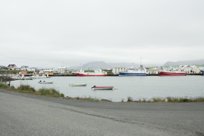
|
|
The port in Höfn (big image, small). |
The Arctic Terns were breeding in the neighborhood, too, and right aggressive they were in guarding their nests if they thought you were threatening them. At one point I felt just like Tippi Hedren. I have a picture from 1969, taken from below, that could be a perfect copy of some of those I got, except that now I was photographing in color.
We drove from there to the little town of Djúpivogur, where we had kleinur and coffee. A kleina is a doughnut rather larger than an American, with corners, and twisted before the cooking. Mark has a picture on his page of me eating one.
|
Somewhere between Höfn and Djúpivogur, we stopped by the sea for a little walk. My journal doesn’t mention the pause, and Mark doesn’t say anything about it either. | |||||||||||||
|
From Djúpivogur, we drove along the south shore of Berufjörður, inland and upwards to Egilsstaðir, on the long lake called Lagarfljót. Along the way, however, we drove along the eastern slopes of a valley whose western slopes were the most unearthly beautiful sight. Like long staircases that marched for miles along the valley, the inner angles filled with debris. Because the climate there is harsh, there was virtually no vegetation greening the cliffs and slopes, just grim brown volcanic rock. The day was cloudy enough and hazy enough that we could not see the top of the formation, nor how far into the distance it might extend. I could think only of Mordor.
In Egilsstaðir, we stopped for fuel and a pit stop, but most of us didn’t get out. It was clear that from here on, the weather would be very warm.
| ||||||||||||||
| ||||||||||||||
| ||||||||||||||
| ||||||||||||||
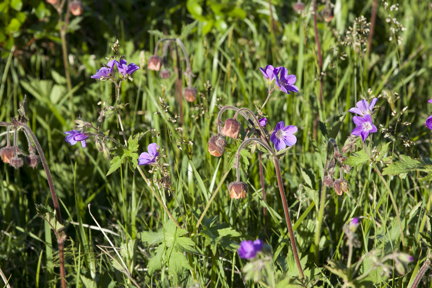
| ||||||||||||||
| Big image, small. |
Our goal was Seyðisfjörður, but we stopped about three miles short of that town, at a point on the Fjarðará (“Fjord River”). And all of us but Gisele and Jerye got out for an amazing walk down along the river to a trailhead where Hulda would pick us up. Past many an impressive waterfall, and at one point with all of us clinging tightly to a cliff with water dripping down it, as we came off one steeply-descending path to get to another. I found this somewhat scary, but Erling coaxed us through it very confidently.
The one other tricky place was at the very end of the walk, where one section of a bridge over a dam had broken away, and for those who were less skilled or less trusting of their own ability, very daunting. I found this far less of a challenge than the drippy cliff, ’cause there were handholds that I could use while extending my foot out over the void. But Erling had to grab a couple of the women about the torso to guide them across.
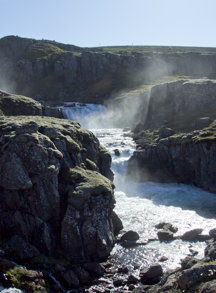
|
| Big image, small. |
But let me comment a little on the pictures in the block to the right that extends way down: The top left snap shows one of the several views we got while we were walking, down towards Seyðisfjörður in the distance. As I said just before, we didn’t walk into town from here, just to a point on the highway where Hulda was waiting for us. Two below that, you can see the town again, beyond Mark, in slightly different perspective, since we had walked a bit to the right by then. The second tall picture shows the typical landscape we were going through: no trail to speak of, just wonderful spongy (not wet!) vegetation that must receive visitors like us only occasionally at best.
The first row of wildflowers shows Mountain Avens (Dryas octopetala) and Moss Campion (Silene acaulis). The Mountain Avens is really interesting, as a member of the Rose family that doesn’t have five petals, but eight instead. And when I was reading about the ice ages of Europe, I would often see mention of the “younger Dryas” cold snap (it lasted only 1300 years)—it turns out that it’s named for the pollen of this flower, which is unusually abundant in deposits from that time. The row below that has something that might be Crowberry (Empetrum nigrum) but probably isn’t, while the right-hand picture is definitely of Bearberry (Arctostphylos uva-ursi).
Next row, on the way downhill, you see there’s no trail or path at all. You did have to watch your step, ’cause there could be cavities to step into. The nice purple flower in the vertical composition is Geranium sylvaticum, known variously as Wood Cranesbill or Woodland Geranium. Standing on the cliff in the picture to the left of that are Margie, Diane, Erling, John, Ronnie, and Shirley. They’re evidently waiting for Mark and Jonathan to catch up.
Below that, you know that with all the waterfalls, there has to be at least one rainbow. I think the one in the left-hand picture there was the only one I saw this day. They really can’t be photographed in any satisfactory way, unfortunately. The last picture shows a mixture of Wood Cranesbill and Water Avens—the latter is the plant I used to head up the central page for this trip. I still think of it as Street-lamp Flower.
After we got past the bridge-that-was-not-quite-complete, it was a short walk to where Hulda was waiting for us in the bus, and a short drive into the town of Seyðisfjörður, population about 800. It’s where the only ferry to Europe lands: if you want to drive to Iceland, as quite a few Germans seem to have done when we were there, you go first to Hanstholm in Jutland, the Danish mainland.
You’d think that this would not be the recipe for a draw for the tourists. But the meal we had on our second night there might make you change your mind on that issue. But more of that tomorrow.
Hulda drove us directly to our lodging, Hotel Aldan (“The Wave”), where our room was the very nicest we stayed in during this trip: pleasantly decorated with old furniture, and bright with huge windows. After a shower, we walked to dinner—the dining room and reception are in a different building a few doors away. Kristín had asked us when we were approaching Seyðisfjörður how many wanted to have reindeer steak. Almost all of us, it turned out: Mark may have been the only one to demur, what with his Ronda-based avoidance of meat from any cervid ungulate.
So we dined on reindeer steak, with one chicken breast, which Mark declared to be perfectly cooked. The venison was excellent too: just properly medium-rare. But as we were getting our food, a small group of people at the next table were having rack of lamb, and that Did Look Good. We knew that the next night, we would be on our own for supper, and Mark and I agreed that we would try the lamb then. Our meal tonight, though, finished off with beer ice cream. My journal says that this did not charm me, even though I tasted no beer in it.
Small as Seyðisfjörður is, the town does have a pub, and Paul stood us all to a drink there. But Mark and I were more interested in kaffi, since coffee hadn’t been part of the dinner at Aldan. And from there to bed, turning in at about 11:30, when, naturally enough, the day was still bright.
Next day’s pictures, previous day’s pictures. Return to the central Iceland page; to the central travel page; to my home page.